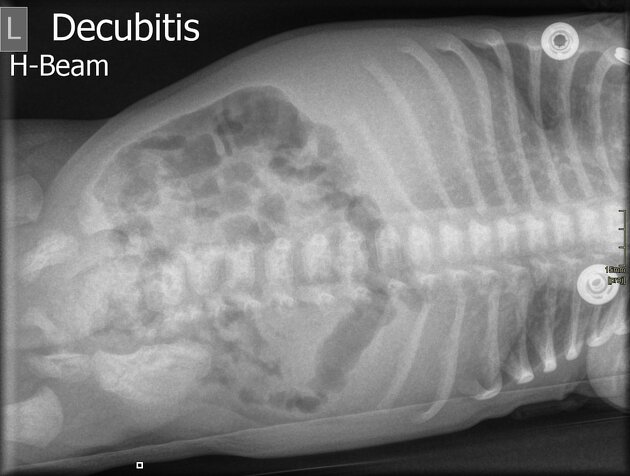The lateral decubitus radiograph is an additional projection for assessing the pediatric abdomen. This view is ideal for displaying free gas in the abdomen and/or if the patient is unable to lie supine 1. As radiation dose is an important consideration for pediatric imaging, the lateral decubitus view is not often performed; although this will vary based on the department.
On this page:
Patient position
patient is in a left lateral decubitus position with both knees bent up
ensure no rotation of hips and shoulders
remove any radiopaque items (e.g. ECG dots, diaper, shiny decorative clothing)
take the x-ray in full inspiration
Technical factors
-
posteroanterior projection
in order to reduce the radiation dose to radiosensitive organs 1
-
centering point
the midsagittal plane (xiphisternum) at the level of the iliac crest
collimation
-
laterally to the lateral abdominal wall
superior to the diaphragm
inferior to the inferior pubic rami
it is not advised to collimate too tightly laterally in case of missing bowel loops and/or organs 1
-
orientation
portrait
-
detector size
will vary depending on the child's body habitus
-
exposure 2
60-75 kVp
2-10 mAs
-
SID
100 cm
-
grid
if patient thickness is above 10 cm, use of a grid is advisable 2
Image technical evaluation
-
include the
lateral abdominal wall
inferior pubic rami inferiorly
must include the diaphragm superiorly
-
the abdomen should be free from rotation with symmetry of the:
ribs (superior)
iliac crests (middle)
obturator foramen (inferior)
no blurring of the bowel gas due to respiratory motion
Practical points
it may be useful to position the patient so that they can see their parents in order to reduce anxiety
pediatric patients may feel uncomfortable when bony landmarks are felt for, therefore an appropriate explanation to the patient beforehand is ideal for improving patient comfort
-
to achieve sufficient inspiration, using child-appropriate language will be useful
e.g. 'breathe in as if you are about to go diving underwater!', 'breathe in as if you are about to blow out a birthday candle!'
Immobilization techniques
It is important for the image to be free from movement artifact and rotation to avoid repeated x-rays.
it may be necessary for the parent or radiographer to stand with the patient or hold them in position
sometimes it is only necessary to keep the child's arms away from the abdominal area; in these cases, asking the child to hold onto something to their side (e.g. toy, mother's hand, pole) may be useful.
techniques will vary based on the department





 Unable to process the form. Check for errors and try again.
Unable to process the form. Check for errors and try again.